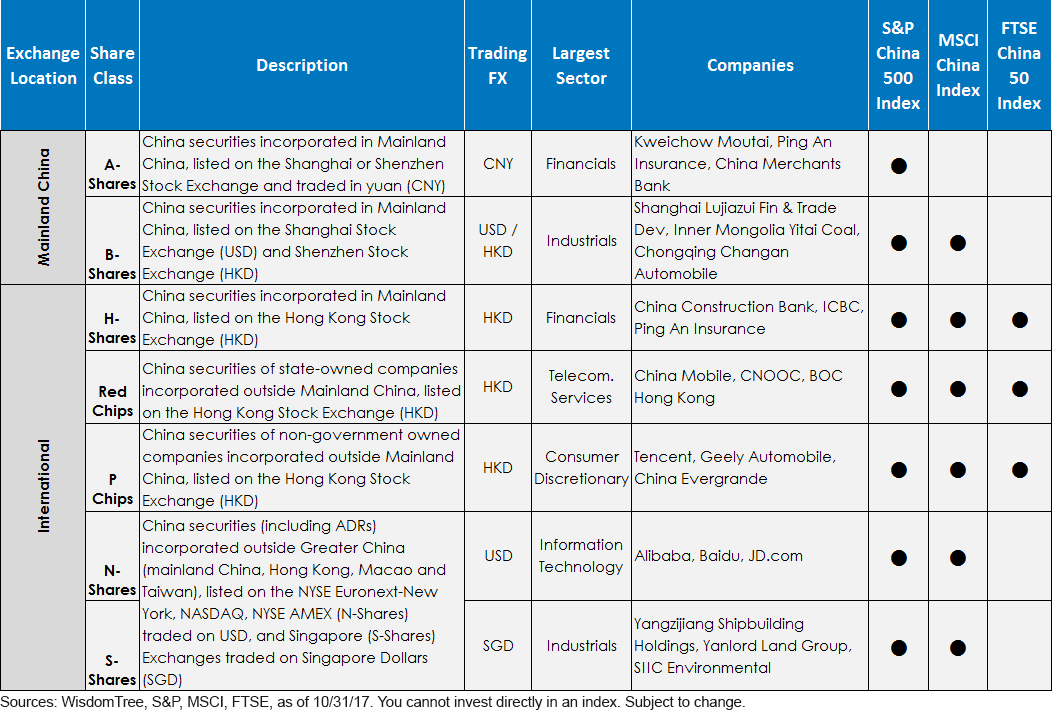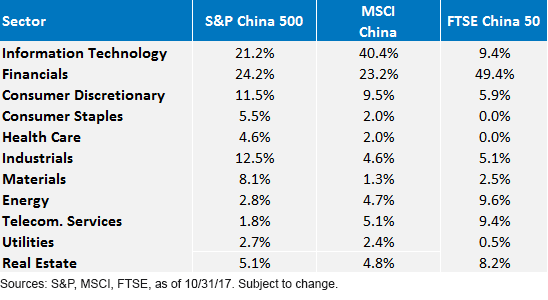Evolving Access to Chinese Equities


As China continues down the path of capital market liberalization, many investors are confronted with a dizzying array of options: H-shares, B-shares, A-shares, P chips. Shares listed in Hong Kong, Shanghai, Shenzhen, Singapore and New York. While the economic rationale for investing in China may be straightforward, the means by which investors should be gaining access is not. In our view, given the diversity of opportunities in the market, any investor seeking “beta” exposure to Chinese equities should seek exposure via all means available.
China by the Numbers
The Chinese economy accounts for more than 15% of global gross domestic product (GDP) and 11% of global trade.1 When measured purely by market cap, China has the second largest equity market in the world.2 However, as a result of restrictions imposed by the Chinese government, these massive markets have generally been off limits for most investors. Over the last decade, Chinese policy makers led by President Xi Jinping have sought to gradually open Chinese markets to outside capital. As a result, China appears to offer an attractive mix of high growth rates, a burgeoning middle class and an economy poised to climb the value chain from export-oriented growth. In our view, China’s importance in global markets will only grow as the government transitions to increase integration among global investors.
Historically, exposure to Chinese equities for non-Chinese nationals was limited to companies that listed on international exchanges. After a variety of pilot programs and special institutional frameworks, China has made dramatic steps forward over the last several years to make mainland-listed companies more accessible to global investors. As a result, we believe investors should not necessarily limit themselves to certain listing venues when constructing exposure to China. As we show below, the S&P China 500 Index is one of the only broad-based indexes offering exposure to all flavors of Chinese stocks.
Chinese Equity Market Overview

Additionally, the S&P approach targets a much broader number of securities (500+) for constructing the Index. In other approaches, as few as 50 stocks are expected to provide a diversified basket. Unfortunately, this currently means that investors would be forced to take a fairly concentrated position in information technology stocks by investing via the MSCI China Index or a nearly 50% weight to financials in the FTSE China 50 Index.
Index Sector Exposures as of 10/31/17

While MSCI’s China A-shares announcement last summer got investors thinking about these issues, the proposed changes won’t take effect until May 2018. For investors who are thinking about how to efficiently gain broad-based exposure to all flavors of Chinese stocks, we just launched an ETF that tracks the S&P China 500 Index, the WisdomTree ICBCCS S&P China 500 Fund (WCHN).
1Source: IMF, as of 9/30/17.
2Source: World Federation of Exchanges, as of 9/30/17
Important Risks Related to this Article
While MSCI’s China A-shares announcement last summer got investors thinking about these issues, the proposed changes won’t take effect until May 2018. For investors who are thinking about how to efficiently gain broad-based exposure to all flavorsThere are risks associated with investing, including possible loss of principal. Foreign investing involves special risks, such as risk of loss from currency fluctuation or political or economic uncertainty. The Fund focuses its investments in China, including A-shares, which include risk of the RQFII regime and Stock Connect program, thereby increasing the impact of events and developments associated with the region which can adversely affect performance. Investments in emerging or offshore markets are generally less liquid and less efficient than investments in developed markets and are subject to additional risks, such as risks of adverse governmental regulation and intervention or political developments. The Fund’s exposure to certain sectors may increases its vulnerability to any single economic or regulatory development related to such sector. As this Fund can have a high concentration in some issuers, the Fund can be adversely impacted by changes affecting those issuers. The Fund will be required to include cash as part of its redemption proceeds which introduces additional risks, particularly due to the potential volatility in the Chinese market and market closures. The Fund invests in the securities included in, or representative of, its Index regardless of their investment merit and the Fund does not attempt to outperform its Index or take defensive positions in declining markets. Due to the investment strategy of this Fund it may make higher capital gain distributions than other ETFs. Please read the Fund’s prospectus for specific details regarding the Fund’s risk profile. of Chinese stocks, we just launched an ETF that tracks the S&P China 500 Index, the WisdomTree ICBCCS S&P China 500 Fund (WCHN).
The Global Industry Classification Standard (“GICS”) was developed by and is the exclusive property and a service mark of MSCI Inc. (“MSCI”) and Standard & Poor’s (“S&P”), a division of The McGraw-Hill Companies, Inc. and is licensed for use by WisdomTree Investments, Inc. Neither MSCI, S&P nor any other party involved in making or compiling the GICS or any GICS classifications makes any express or implied warranties or representations with respect to such standard or classification (or the results to be obtained by the use thereof), and all such parties hereby expressly disclaim all warranties of originality, accuracy, completeness, merchantability and fitness for a particular purpose with respect to any such standard or classification. Without limiting any of the foregoing, in no event shall MSCI, S&P, any of their affiliates or any third party involved in making or compiling the GICS or any GICS classifications have any liability for any direct, indirect, special, punitive, consequential or any other damages (including lost profits) even if notified of the possibility of such damages.


